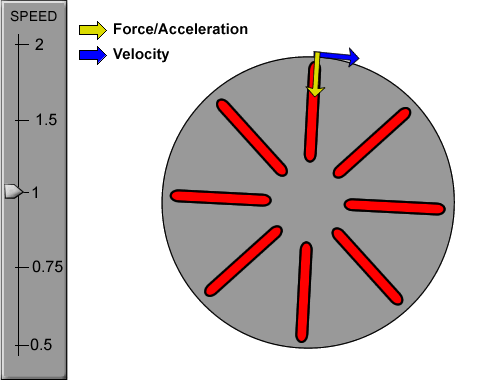Newton’s Laws of Motion
To understand Newton's laws, we first need to know a little about motion and forces. We describe motion in terms of velocity and acceleration.
| Velocity: The rate of change of displacement of an object (displacement over elapsed time) is velocity. Velocity is a vector since it has both magnitude (called speed) and direction. For example, if you drive 10 miles North in 0.25 hours (15 minutes), your velocity is 10 miles/0.25 hours = 40 mph in the northerly direction. For further explanation of vectors click here. |
| Acceleration: The rate of change of velocity is acceleration. Like velocity, acceleration is a vector and has both magnitude and direction. For example, a car in straight-line motion is said to have forward (positive) acceleration if it is speeding up and rearward (negative) acceleration if it is slowing down. We sometimes refer to negative acceleration as deceleration. |
| Force: A force is a push or a pull on an object. |
Newton's Laws of Motion
First Law: |
An object at rest or traveling in constant, straight-line motion (a state of no acceleration) will remain at a constant velocity unless acted upon by an outside force. |
This law is illustrated in the movie below:
|
|
Once the ball is set in motion, it continues to move in a straight line at a constant velocity because its motion is not altered by any forces. We say the momentum of the ball is conserved (unchanged). A moving ball of mass m has momentum  where
where  is the ball velocity.
is the ball velocity.
Second Law: |
The rate of change of momentum of an object is equal to the net force acting on the object. |
For an object with a constant mass m this can be expressed as

where  is the acceleration of the object and
is the acceleration of the object and  is the net force acting on the object. For more in-depth discussion click here.
is the net force acting on the object. For more in-depth discussion click here.
A special case of this law occurs when the net force acting on an object is zero ( ). In this case, the acceleration of the object is zero and it continues in its present state of motion in agreement with the 1st Law.
). In this case, the acceleration of the object is zero and it continues in its present state of motion in agreement with the 1st Law.
Conversely, the 2nd Law tells us that a net or unbalanced force must be applied to an object to change its motion. Because a force is a vector (described by both a direction and a magnitude), the motion of an object can be altered in two ways:

Two funny cars racing. Photographed by David Jeon. |
|
Click on the photos above to see the high resolution images. |
|

|
 |

|
Example Problem: Cleared for Takeoff |
Third Law: |
For every force in nature, there is an equal, but opposite reaction. |
An example of the third law is illustrated below with two people on skateboards. Andy pushes on Bob in order to move Bob away from him. That is, Andy applies a force to Bob,  . In the process, however, Andy begins moving in the opposite direction. Thus, according to the 2nd Law, a force must have been applied to Andy by Bob (
. In the process, however, Andy begins moving in the opposite direction. Thus, according to the 2nd Law, a force must have been applied to Andy by Bob ( ). The 3rd Law states that these forces are equal in magnitude an opposite in direction:
). The 3rd Law states that these forces are equal in magnitude an opposite in direction:

|
|
